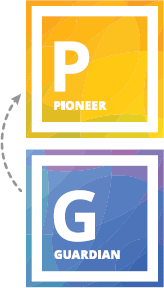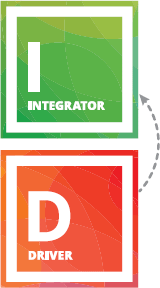

Creating Powerful Relationships with Colleagues, Customers, and Everyone Else
By now it's no doubt clear to you that each type can contribute significant value—as a partner, within a team, and to an organization—and that the needs of each differ, often dramatically. We've shared lots of details about each type's nightmare work scenarios, how these situations can negatively affect their performance, and what can help make things better for them (and for you). Now we're going to tackle this issue from a slightly different angle. In this chapter we'll specifically address how your type impacts the ways in which you should flex to best work with others.
Flex is a funny word, because it can mean seemingly contradictory things—to bend and stretch, but also to tighten and contract. We like that apparent incongruity because the concept here is that sometimes you need to tweak your style to adjust to other people's needs, while also being true to yourself. There's an inherent and healthy tension in that. You shouldn't become a different person and act completely out of character, but you should make an effort to accommodate others' preferences and needs. That's how you exercise that gem-grade empathy mentioned in Chapter 1, and how you ultimately create powerful relationships. And hopefully the other person is flexing too so you can meet in the middle, like the rubber bands Kim talked about in chapter 14. When it comes to one-on-one relationships, how you go about flexing, and how challenging it's likely to be, depends on your type and that of the other person.
When Opposites don't Attract
We'll start with flexing to your opposite type, because it's often the most difficult for people, particularly if one or both of you are on the more extreme end for your type. Flexing to your opposite usually requires conscious focus and lots of practice. It's worth it because the strengths of your opposite type are often in the areas where you have weaknesses, so working together can be really powerful. Just like a certain pair of twins from another planet—remember that cartoon? “Wonder Twin powers activate!” When the twins were out of each other's reach they couldn't activate their shape-shifting powers. It was only together that they were super heroes. But you don't need to be a shapeshifter to flex to your opposite type. We've already given you lots of clues for how to do it. Remember?
Let us remind you, just in case. We suspect as you read the previous four chapters you may have paid particular attention to the chapter about your own type, sort of like when you look through your old high school yearbooks. That's me! There I am again! But may we gently suggest you tear yourself away from your own image and do a thorough read-through of the chapter about your opposite type. There, you'll find lots of ideas about what your opposite type wants and needs, and how you might contribute to making conditions right for them to perform at their best. After all, isn't that what you want from all of your colleagues, team members, and stakeholders?
We know that more information is sometimes better—especially when doing something that may be unfamiliar—so the next four pages offer more specific hints for how to go about flexing to your opposite type.
Engaging a Pioneer if You're a Guardian
As a Guardian you may not realize that imposing too much structure or specifying too many details about a project can box a Pioneer in and leave them without the space they want to get creative. Backing off and providing more high-level guidance instead of detailed instructions might be the key.

Try to…
 Keep things moving. Quicken the pace of pretty much everything. Pioneers can be fast talkers and thinkers, and they can be prone to boredom. Build variety into meetings and projects to keep them engaged.
Keep things moving. Quicken the pace of pretty much everything. Pioneers can be fast talkers and thinkers, and they can be prone to boredom. Build variety into meetings and projects to keep them engaged. Whiteboard it. Since ideation is in their blood, let them explore big ideas in a visual way. Think brainstorm.
Whiteboard it. Since ideation is in their blood, let them explore big ideas in a visual way. Think brainstorm. Don't push details. Keep things high level and expansive so that Pioneers don't tune out. Too many details or rules make them feel constrained.
Don't push details. Keep things high level and expansive so that Pioneers don't tune out. Too many details or rules make them feel constrained. Silence your skeptic. To avoid shutting a Pioneer down, temporarily suspend your disbelief or doubts and just go with it. If you have concerns share them later, rather than sooner.
Silence your skeptic. To avoid shutting a Pioneer down, temporarily suspend your disbelief or doubts and just go with it. If you have concerns share them later, rather than sooner. Deliver an experience. Change things up. Present a new idea to Pioneers by allowing them to experience it—play a song, let them experience something via touch, hold a meeting outside of the office. Seriously.
Deliver an experience. Change things up. Present a new idea to Pioneers by allowing them to experience it—play a song, let them experience something via touch, hold a meeting outside of the office. Seriously. Tolerate the chaos. Pioneers have their own processes for creation and they may seem to go all over the place. Build time into the agenda for them to do so and wait a while before trying to bring them back to earth.
Tolerate the chaos. Pioneers have their own processes for creation and they may seem to go all over the place. Build time into the agenda for them to do so and wait a while before trying to bring them back to earth. Bring passion! Show the excitement in your idea by bringing conviction and interest. Sell it!
Bring passion! Show the excitement in your idea by bringing conviction and interest. Sell it!
Our overall recommendation for engaging a Pioneer is go big, buckle up, and enjoy the ride!
© 2018. Deloitte Touche Tohmatsu Limited
Engaging a Guardian if You're a Pioneer
If you're an anything-goes Pioneer, you might be challenged to provide an environment where a more practical Guardian will thrive. You may want to give more consideration to the structure they crave and the time and information they need to make a decision.

Try to…
 Give them time to process. Guardians don't appreciate being put on the spot. Provide materials or expectations in advance so they can make careful considerations and come to a discussion prepared.
Give them time to process. Guardians don't appreciate being put on the spot. Provide materials or expectations in advance so they can make careful considerations and come to a discussion prepared. Provide data. Point them in the right direction to find the details they need, and anticipate that they're going to ask additional questions.
Provide data. Point them in the right direction to find the details they need, and anticipate that they're going to ask additional questions. Cite your sources. Rather than making sweeping generalities, be precise and cite evidence for how you reached your conclusion.
Cite your sources. Rather than making sweeping generalities, be precise and cite evidence for how you reached your conclusion. Make it linear and concrete. Rather than speaking at a theoretical level, make your idea practical. Follow a logical and linear, step-by-step approach to help Guardians understand what's been done and how you got to where you did.
Make it linear and concrete. Rather than speaking at a theoretical level, make your idea practical. Follow a logical and linear, step-by-step approach to help Guardians understand what's been done and how you got to where you did. Respect the agenda. Be punctual, stay on task, and run your meeting using a clear structure.
Respect the agenda. Be punctual, stay on task, and run your meeting using a clear structure. Honor precedent. Guardians may be more comfortable with what is tried and true. Relate your idea to something familiar or that's worked in the past.
Honor precedent. Guardians may be more comfortable with what is tried and true. Relate your idea to something familiar or that's worked in the past. Keep emotions in check. Be calm and thoughtful in your approach.
Keep emotions in check. Be calm and thoughtful in your approach.
Our overall recommendation for engaging a Guardian is be prepared.
© 2018. Deloitte Touche Tohmatsu Limited
Engaging a Driver if You're an Integrator
As an Integrator, you may be so diplomatic and dead-set on providing lots of context that a Driver loses patience or is left not understanding what your stance on an issue actually is. You may need to work toward being more direct and concise so they know where you stand and you don't lose their attention before they get there.

Try to…
 Get your facts straight. Make sure you know what you're talking about, and then don't be afraid to strut your stuff a little bit.
Get your facts straight. Make sure you know what you're talking about, and then don't be afraid to strut your stuff a little bit. Assert your point of view. Bring a recommendation and stand by it. Drivers expect you to have a point of view, and you may lose their respect if you don't have one.
Assert your point of view. Bring a recommendation and stand by it. Drivers expect you to have a point of view, and you may lose their respect if you don't have one. Lead with the punchline. Structure a discussion backwards; start with your main point and then provide facts to support your message.
Lead with the punchline. Structure a discussion backwards; start with your main point and then provide facts to support your message. Build a logical argument. Concisely take them through your thought process and bring the evidence.
Build a logical argument. Concisely take them through your thought process and bring the evidence. Anticipate pushback and preempt objections. Drivers will challenge your stance as they think it through and they will poke holes in their attempts to validate it. Be ready to back it up. Drivers appreciate critical thinking, so talk through obvious counterarguments to your proposal or idea.
Anticipate pushback and preempt objections. Drivers will challenge your stance as they think it through and they will poke holes in their attempts to validate it. Be ready to back it up. Drivers appreciate critical thinking, so talk through obvious counterarguments to your proposal or idea. Keep it tight. Avoid excessive small talk, prolonged scene-setting, or too much pomp and circumstance. Don't carry on too long—Drivers appreciate you getting to the point, and doing so quickly and directly.
Keep it tight. Avoid excessive small talk, prolonged scene-setting, or too much pomp and circumstance. Don't carry on too long—Drivers appreciate you getting to the point, and doing so quickly and directly. Propose an experiment. Appeal to both their scientific side and desire to move fast; prototype an idea sooner rather than later.
Propose an experiment. Appeal to both their scientific side and desire to move fast; prototype an idea sooner rather than later.
Our overall recommendation for engaging a Driver is to be smart, be quick, be gone.
© 2018. Deloitte Touche Tohmatsu Limited
Engaging an Integrator if You're a Driver
As a Driver you may mistakenly try to push an Integrator in a particular direction with a black-and-white, logical argument, since that tends to work best for your own Driver-nature. Instead, slow down and focus in on the person in front of you to bring them along more gradually.

Try to…
 Ask questions and listen. If an Integrator expresses discomfort or displays resistance, ask for clarification. Listen to their response and reflect it back to check your understanding of their true issue.
Ask questions and listen. If an Integrator expresses discomfort or displays resistance, ask for clarification. Listen to their response and reflect it back to check your understanding of their true issue. Share context. Integrators have the greatest need for the big picture. Help them see how things fit together so they understand the purpose of a project or task.
Share context. Integrators have the greatest need for the big picture. Help them see how things fit together so they understand the purpose of a project or task. Co-create. Work together to build on an idea or plan in a collaborative format.
Co-create. Work together to build on an idea or plan in a collaborative format. Don't rush. Create room for them to synthesize separate data points and socialize ideas and opinions before coming to a conclusion.
Don't rush. Create room for them to synthesize separate data points and socialize ideas and opinions before coming to a conclusion. Be open to alternatives. Integrators prefer an iterative and collaborative process, and they're prone to changing their minds; anticipate an alternative solution or compromise.
Be open to alternatives. Integrators prefer an iterative and collaborative process, and they're prone to changing their minds; anticipate an alternative solution or compromise. Get personal. Humanize the proposal or idea you're putting forward, pointing out the impacts on actual people. Involve the heart and head. Don't just ask Integrators what they think about a matter, ask them how they feel about it. One way to captivate an Integrator and give them context is to tell a compelling story, making a concept real and relatable rather than theoretical.
Get personal. Humanize the proposal or idea you're putting forward, pointing out the impacts on actual people. Involve the heart and head. Don't just ask Integrators what they think about a matter, ask them how they feel about it. One way to captivate an Integrator and give them context is to tell a compelling story, making a concept real and relatable rather than theoretical. Don't be a jerk. Integrators like to play nice; if you're overly aggressive, rude, or abrasive, they will shut down. Be aware that the Integrator thinks you're acting like a jerk much sooner than you do.
Don't be a jerk. Integrators like to play nice; if you're overly aggressive, rude, or abrasive, they will shut down. Be aware that the Integrator thinks you're acting like a jerk much sooner than you do.
Our overall recommendation for engaging an Integrator is to practice a bit of give and take.
© 2018. Deloitte Touche Tohmatsu Limited
When you've Got Too Much in Common
You may think that when you're working with someone who's the same type as you, you're on easy street. But like-type pairs can quickly find themselves in trouble. Two Drivers might end up in a power struggle, while a pair of Integrators may get stuck in an endless loop of considering and reconsidering every option in light of all the input they've gathered. A couple of Guardians together may analyze a problem to death and never make a decision, while a Pioneer duo might make very little progress on some really great ideas because they come up with even more great ideas before they can implement the first ones.
If you find yourself in a situation with someone of your same type, your goal is still to flex, but not to get closer to the other person's style. Instead, you want to get a little bit further away. You might do this by digging deeper and channeling your secondary type, like we talked about in Chapter 7. For example, if you're an Integrator working with another Integrator, lean into your Pioneer or Guardian traits to bring a different perspective into the mix. The great thing is, if you and your colleague are both in the Business Chemistry boat you can acknowledge what you're trying to do. You might say something like, “Since we're both Integrators I'm afraid we're going to have a hard time landing on a final answer, so I'm going to channel my secondary Pioneer to help get us there.” Your fellow seadog will know just what you mean.
The next page offers some quick tips for each of the types to help prevent your greatest strengths from becoming your greatest weaknesses.
If You're a Pioneer Working with Another Pioneer

Try to bring things back down to earth. After you've enjoyed some time brainstorming cool ideas, focus on developing actionable next steps so the path forward becomes clear.
If You're a Driver Working with Another Driver

While debating an issue, avoid tunnel vision by bringing up context or the human implications to get a broader view. Otherwise you may end up driving a bus together with no one else on board.
If You're an Integrator Working with Another Integrator

Temper your shared desire to explore all alternatives and settle on a direction. If there's an elephant in the room address it, even if it's uncomfortable.
If You're a Guardian Working with Another Guardian

Challenge yourself to ask whether the current way of doing things is really the best way to reach your goal. Avoid fixating on unknowns and instead focus on what is necessary to move ahead.
© 2018. Deloitte Touche Tohmatsu Limited
When You Need to Flex Just a Little
So we've covered how you might need to flex to your opposite type and flex away from your own type. But what about the other types—those with whom you share some traits despite your differences? We'd like to invite you to sit on the floor for a moment. Come on, give it a try… chances are you've been sitting in that chair too long anyway. Now, put your feet straight out in front of you and reach for your toes (without bending your knees!). Is it challenging? Probably. (If not, then we'd like to know your stretching regimen so we can adopt it.) Now reach for your shins; it should be easier. Flexing to your adjacent type is more like reaching for your shins than your toes. You might feel the pull a little, but likely not too much. Here are some tips.
| If you're a PIONEER working with a DRIVER… |
| Your naturally bold and quick thinking is likely to engage a Driver. Go ahead and bring your out-of-the-box ideas; Drivers like to explore too. And feel free to spar a little, you're both likely to thrive on it. But don't lose sight of logic or practicality. Pie-in-the-sky isn't going to work here and ill-considered risks will likely not be embraced. |
| If you're a PIONEER working with a INTEGRATOR… |
| You're likely to have a lot in common with an Integrator, including a tendency toward big-picture thinking, an appreciation for context, and an expressive, collaborative style. Your storytelling skills will be an asset, and if you can make your stories about people, even better. The Integrator is likely to move a bit more slowly than you and to spend more energy on gauging the opinions of other people, so hold your horses and indulge their desire to bring others along for the ride. |
| If you're a GUARDIAN working with a DRIVER… |
| Start with the punchline. Drivers appreciate logic, data, and analysis just like you do, but you'll lose a Driver's attention if you try to take them through your full thought process. Come prepared with the facts, but once they've gotten the point, stop talking. |
| If you're a GUARDIAN working with a INTEGRATOR… |
| The Integrator shares your distaste for confrontation, so make sure any issues that need to be discussed are surfaced and not ignored. Be patient with discussions that may seem tangential, an Integrator's way of thinking through an issue may be more roundabout than yours. Start with some personal connections before launching into planning, and then provide the facts and structure that an Integrator may not naturally seek, as well as the context they need. |
| If you're a DRIVER working with a PIONEER… |
| You and a Pioneer may find a groove by exploring new approaches and experimenting together. You can help bolster the ideas you co-create by providing the facts to support them, but be careful not to go too deep into logic; Pioneers are more interested in possibility. You may also need to be cautious about being overly direct or trying to run the show. Pioneers are very collaborative but they also like to be in charge and bristle against feeling controlled. |
| If you're a DRIVER working with a GUARDIAN… |
| You may need to access your reserve tank of patience. Like you, Guardians thrive on facts and data, but they're likely to need more of both than you are, and they'll probably take longer in considering them. Be prepared to continue reviewing the details even if you've already reached a conclusion yourself, and don't attempt to take shortcuts. |
| If you're an INTEGRATOR working with a PIONEER… |
| You and a Pioneer could be great collaborators, as you both value working closely with others. You may also enjoy thinking big together, but don't forget to address critical details, something neither of you is likely to do naturally. You might need to pick up the pace, as Pioneers like to move quickly and they may feel impatient with your tendency to consider things more thoroughly. |
| If you're an INTEGRATOR working with a GUARDIAN… |
| A Guardian will likely appreciate your tendency to be introspective and considered; it's something you have in common. Your nonconfrontational style can also be an asset, because a Guardian is likely to be as conflict-avoidant as you are. Just make sure that important issues get addressed when needed, even if they're difficult to broach. You may need to adjust your level of structure and focus a bit to fit with a Guardian. Your non linear thinking style can feel scattered to them and your big-picture focus won't give them the specifics they're likely to need. |
© 2018. Deloitte Touche Tohmatsu Limited
Flexing with Strangers
One final note about flexing. So far we've focused primarily on how to flex in one-on-one relationships. In the next chapter we'll address how to make Business Chemistry work on your teams, those you interact with on a somewhat regular basis. In both cases you're likely able to observe people over time to develop a hunch about their type, and you probably have the opportunity and incentive to adapt your style, and/or the broader environment, to be more effective together. But what about situations where you're interacting with a group of people that you don't know, or that you've met only once?
Take for instance, a sales presentation. You enter a bland conference room, and around the table eyeballs stare back at you. You might know the names of a few people in attendance, but others you've never met before. How do you use Business Chemistry in a context like that?
Well, to start, it helps to have a sense of the power dynamics. Who is the decision maker in the room? Who is the influencer? Try to do some homework in advance to get a sense of their Business Chemistry; the Internet is your friend in times like this. If you can develop a hunch based on what you find, great (look back at our tips in Chapter 7). You want to tailor your style to those people if you can. If you don't know who has the power, watch the others in the room. Who are they deferring to? Who do they look at most frequently? These are small clues that can give you a sense of the dynamics you're dealing with.
If you really don't have much to go on or aren't confident in your hunch, it's best to assume you'll have all types in the room. Here are some things to consider doing when going in blind:
 Drivers and Pioneers often tune out quickly if you don't capture their interest right away. Consider opening with a quick stat or short engaging story that clearly sets up the point of your discussion.
Drivers and Pioneers often tune out quickly if you don't capture their interest right away. Consider opening with a quick stat or short engaging story that clearly sets up the point of your discussion. Integrators and Guardians appreciate context. If you didn't cover it in your opening, consider briefly setting the scene with how what you're talking about fits in the broader picture.
Integrators and Guardians appreciate context. If you didn't cover it in your opening, consider briefly setting the scene with how what you're talking about fits in the broader picture. Guardians and Drivers may ask detailed questions, particularly if you've been keeping things high level, so bring an appendix of detailed information that you can reference if needed.
Guardians and Drivers may ask detailed questions, particularly if you've been keeping things high level, so bring an appendix of detailed information that you can reference if needed. Pioneers and Integrators will likely be more engaged by things that are visually stimulating. Consider including videos, prototypes, or evocative photos to pique their interest.
Pioneers and Integrators will likely be more engaged by things that are visually stimulating. Consider including videos, prototypes, or evocative photos to pique their interest.
Ultimately, our recommendation is to prepare like a boy or girl scout would. Make sure you have something for each of the types, try some of the tips we've proposed, and then watch the room. See how people respond and then go from there. We've given you lots of suggestions for how to relate to each type already, but here's one last cheat sheet.
 Sensing Guardian – double down on the data and follow a linear path.
Sensing Guardian – double down on the data and follow a linear path. Sensing Driver – get to the point and make sure you can defend it.
Sensing Driver – get to the point and make sure you can defend it. Sensing Integrator – use positive body language and share options and implications.
Sensing Integrator – use positive body language and share options and implications. Sensing Pioneer – make it fun, paint the art of the possible, and get them contributing their own ideas.
Sensing Pioneer – make it fun, paint the art of the possible, and get them contributing their own ideas.
Sure, you can't please everyone all the time, but that doesn't mean you shouldn't try.
